RDA: Resource description and access part 1 - Joint Steering ...
RDA: Resource description and access part 1 - Joint Steering ...
RDA: Resource description and access part 1 - Joint Steering ...
- No tags were found...
Create successful ePaper yourself
Turn your PDF publications into a flip-book with our unique Google optimized e-Paper software.
5JSC/<strong>RDA</strong>/Part I/CILIP response5JSC/<strong>RDA</strong>/Part I/Chapter 3/CILIP response20 March 2005p. 41.6: There’s no equivalent here to the AACR2 1.1B1 rule concerned with changing [ ] to ( ) <strong>and</strong>… to – which will make it more difficult in future to distinguish between data transcribed fromthe resource <strong>and</strong> a cataloguer’s insertions <strong>and</strong>/or omissions.1.6.2: CILIP recommends adding an exception to transcribe in a note long statements; this is<strong>part</strong>icularly valuable for early printed resources.In respect of the option, perhaps the most accurate, consistent <strong>and</strong> simplest rule might even bealways (not optionally) to transcribe the edition statement as it appears on the source. This wouldassist alignment between <strong>RDA</strong> <strong>and</strong> DCRM(B).CILIP also recommends adding the date in arabic numerals (<strong>and</strong> in square brackets) to anyimprint date transcribed in roman numerals, e.g.MDCCXXXIII [1733]This can be essential for searching. It also restores alignment with DCRB.1.6.2.1: CILIP would prefer that, for early printed resources, the option to retain roman numeralsin series numbering (<strong>and</strong> not to substitute arabic numerals, therefore) be provided.1.6.2.5, fn. 4: Reference needs updating to the 2 nd ed.:London : Bowker-Saur, 19991.6.6: It’s necessary here to distinguish more clearly here between transcribing what’s on theitem, <strong>and</strong> what is needed for <strong>access</strong>. There is also no guarantee that the publishers will continuewith any specific graphical layout, <strong>and</strong> such designs sometimes occur on the cover but not on thetitle page. Perhaps the rule needs to be strengthened by insisting on an <strong>access</strong> point for anyvariant title(s), with a note to explain what’s going on.1.6.7: The word substitute is misused in the first parenthesis; we recommend using replaceinstead.1.6.8: The instructions for dealing with inaccuracies gave rise to extensive debate within CILIP.In <strong>part</strong>icular, the discussion highlighted the tension inherent in much of <strong>RDA</strong> (<strong>and</strong> in AACRbefore it) between transcription (helping to identify a <strong>part</strong>icular manifestation) <strong>and</strong> <strong>access</strong>. Therewere many who preferred something closer to the AACR2 rule, without being able clearly todefine what constituted an “error” or how to deal with the implications of interpolating [sic] orwhatever in a machine-readable environment. On the other side of the argument were thosevoices that felt <strong>RDA</strong> shouldn’t be concerned at all with the mechanical process of creating acatalogue record (including the possibility of transcription errors or typographical errors), butwho believed <strong>RDA</strong> to be concerned with intellectual processes.Anticipating a consensus that <strong>RDA</strong>, as now drafted, is the way forward, then CILIP would like tosuggest that the rule includes a brief statement of its raison d’etre:In order to enable identification of the work or manifestation, when instructed to transcribethe element as it appears on the source of information, transcribe an inaccuracy ormisspelled word as it appears on the source, except where instructed otherwise (see xxx<strong>and</strong> xx).


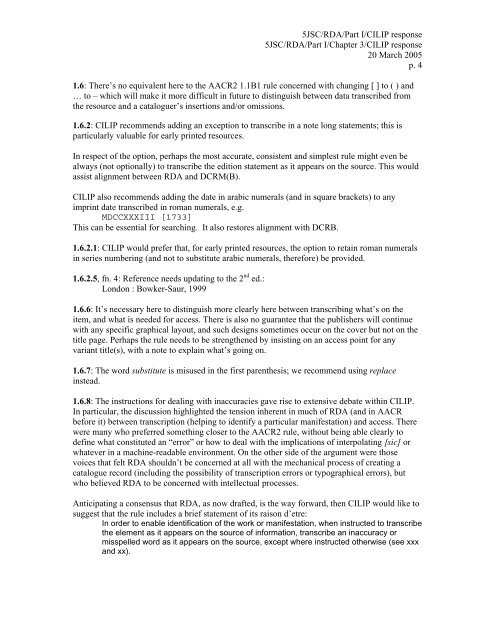

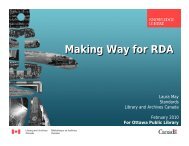
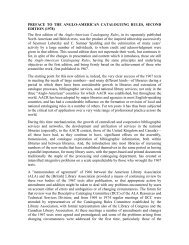
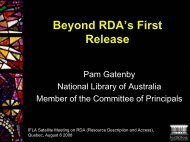



![Presentation slides [PDF] - Joint Steering Committee for ...](https://img.yumpu.com/41621230/1/190x143/presentation-slides-pdf-joint-steering-committee-for-.jpg?quality=85)

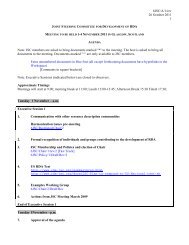
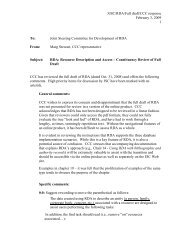
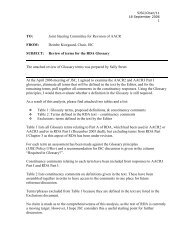
![Presentation slides [PDF] - Joint Steering Committee for ...](https://img.yumpu.com/35256207/1/190x143/presentation-slides-pdf-joint-steering-committee-for-.jpg?quality=85)
